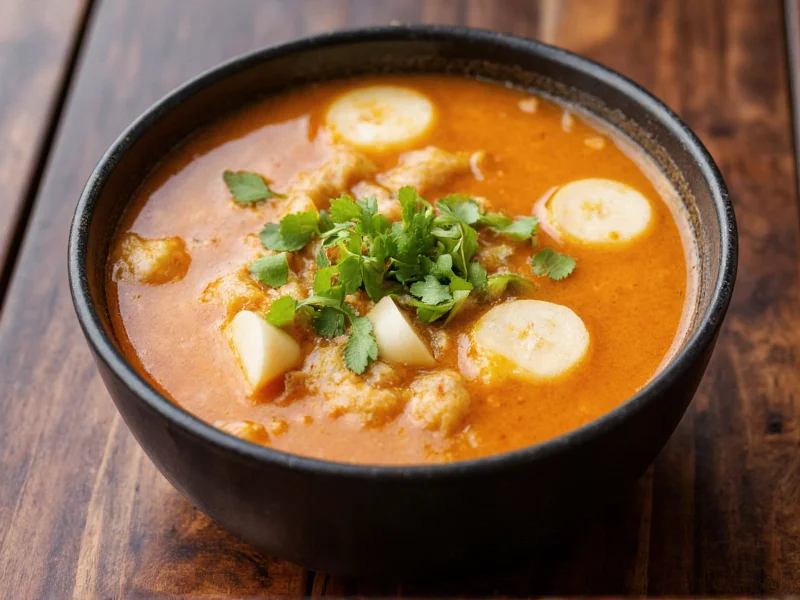Understanding the Fufu and Soup Tradition
Fufu and soup represents one of West Africa's most enduring culinary traditions, dating back centuries. This staple food combination serves as the centerpiece of meals across numerous African cultures, particularly in Ghana, Nigeria, and Cote d'Ivoire. The proper understanding of “fufu soup” begins with recognizing that fufu itself is the starchy accompaniment, while various soups provide the flavorful liquid component that completes the meal.
What Exactly Is Fufu?
Fufu originates from West Africa and functions as a neutral-tasting carbohydrate base that perfectly complements richly flavored soups. Traditionally, fufu is made by boiling starchy vegetables like cassava, plantains, yams, or cocoyam, then pounding them in a mortar with a pestle until they form a smooth, elastic dough. The preparation process requires significant physical effort, which is why many communities gather to prepare fufu collectively during special occasions.
Modern adaptations often use pre-packaged fufu flour for convenience, but purists maintain that authentic fufu requires the traditional pounding method to achieve the proper texture—smooth enough to roll into balls yet firm enough to hold their shape when dipped into soup.
Traditional Soups Served with Fufu
The term “fufu soup” actually refers to the various soup preparations that accompany fufu. These soups fall into several distinct categories based on ingredients and preparation methods:
| Soup Type | Key Ingredients | Regional Origin | Flavor Profile |
|---|---|---|---|
| Light Soup | Tomatoes, peppers, onions, fish or meat | Ghana | Spicy, tangy, aromatic |
| Groundnut Soup | Peanut paste, tomatoes, peppers, meat | Ghana, Nigeria | Creamy, nutty, mildly spicy |
| Palm Nut Soup | Palm fruit extract, fish, leaf vegetables | Nigeria, Cameroon | Rich, earthy, slightly sweet |
| Egusi Soup | Melon seeds, leafy greens, meat | Nigeria | Thick, savory, nutty |
Cultural Significance of Fufu and Soup
The pairing of fufu with soup carries deep cultural meaning throughout West Africa. In many communities, sharing a communal bowl of soup with fufu symbolizes unity and togetherness. The preparation process itself often involves multiple family members—someone pounding the fufu, another preparing the soup, and others gathering ingredients.
Traditional eating etiquette surrounding fufu and soup demonstrates respect for cultural heritage. Diners typically tear off a small piece of fufu, create an indentation with their thumb, and use it to scoop soup. This method requires practice to master, as the fufu must be firm enough to hold the soup without breaking apart.
Regional Variations Across West Africa
While the basic concept remains consistent, fufu preparation and soup recipes vary significantly across West Africa:
- Ghana: Ghanaian fufu typically combines cassava and plantains, served with light soup (tomato-based) or groundnut soup (peanut-based). Banku, a fermented corn and cassava dough, serves as another popular accompaniment.
- Nigeria: Nigerian fufu often uses yams or cassava alone, paired with soups like egusi (melon seed soup) or ogbono (wild mango seed soup). Amala, made from yam flour, represents another common starch.
- Cameroon: Cameroonian fufu frequently incorporates cocoyam, served with eru (a leafy green soup) or ndolé (bitterleaf soup).
- Ivory Coast: Attiéké, made from fermented cassava, serves as the fufu equivalent, typically paired with grilled fish and tomato-based sauces.
How to Eat Fufu with Soup Properly
Understanding how to eat fufu with soup properly enhances the authentic experience. The traditional method involves:
- Washing hands thoroughly before and after eating (as fufu is eaten with hands)
- Tearing off a small piece of fufu (about the size of a golf ball)
- Rolling it between palms to form a smooth ball
- Creating a small indentation with the thumb
- Dipping the fufu into the soup and scooping up some liquid
- Eating the fufu ball with the soup inside
This technique requires practice to perfect, as the fufu must be firm enough to hold the soup without breaking apart. Many West African restaurants outside Africa provide instructions for first-time diners to navigate this unique eating experience.
Finding Authentic Fufu Soup Experiences
For those seeking authentic fufu and soup experiences outside West Africa, several approaches yield the best results:
- Look for family-owned West African restaurants rather than generic “African” establishments
- Ask about specific regional specialties (Ghanaian light soup vs. Nigerian egusi soup)
- Check if they prepare fufu traditionally (pounded fresh) rather than using pre-made versions
- Seek out restaurants with predominantly West African clientele for the most authentic experiences
- Consider visiting during weekends when traditional dishes are more likely to be freshly prepared
When evaluating potential restaurants, observe whether they serve fufu with appropriate soup pairings and provide guidance on traditional eating methods. Authentic establishments often take pride in sharing their culinary heritage and will happily explain proper eating techniques.
Modern Adaptations and Cultural Preservation
As West African communities have spread globally, fufu and soup traditions have evolved while maintaining cultural significance. Many diaspora communities host “fufu parties” where friends gather to pound fufu together, preserving both the culinary tradition and social aspect of the meal.
Food entrepreneurs have developed innovative approaches to making traditional fufu more accessible, including pre-packaged fufu flour and electric fufu pounders. While purists debate whether these adaptations maintain authenticity, they've undoubtedly helped preserve the tradition among younger generations and introduced West African cuisine to new audiences.











 浙公网安备
33010002000092号
浙公网安备
33010002000092号 浙B2-20120091-4
浙B2-20120091-4